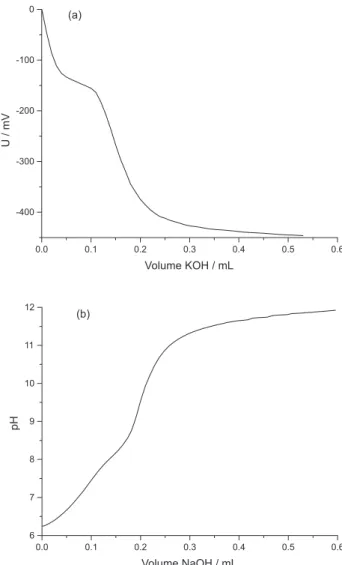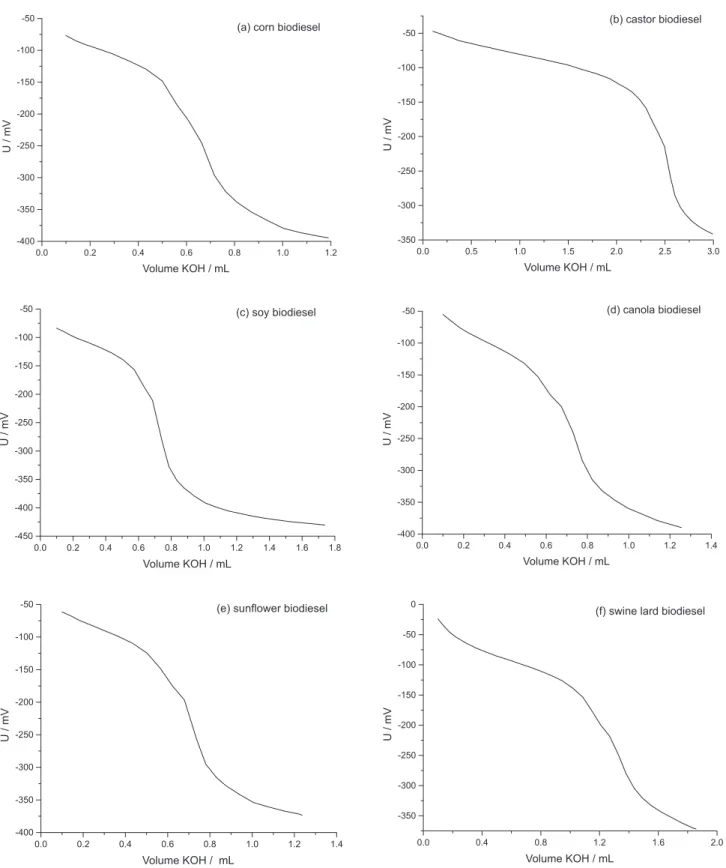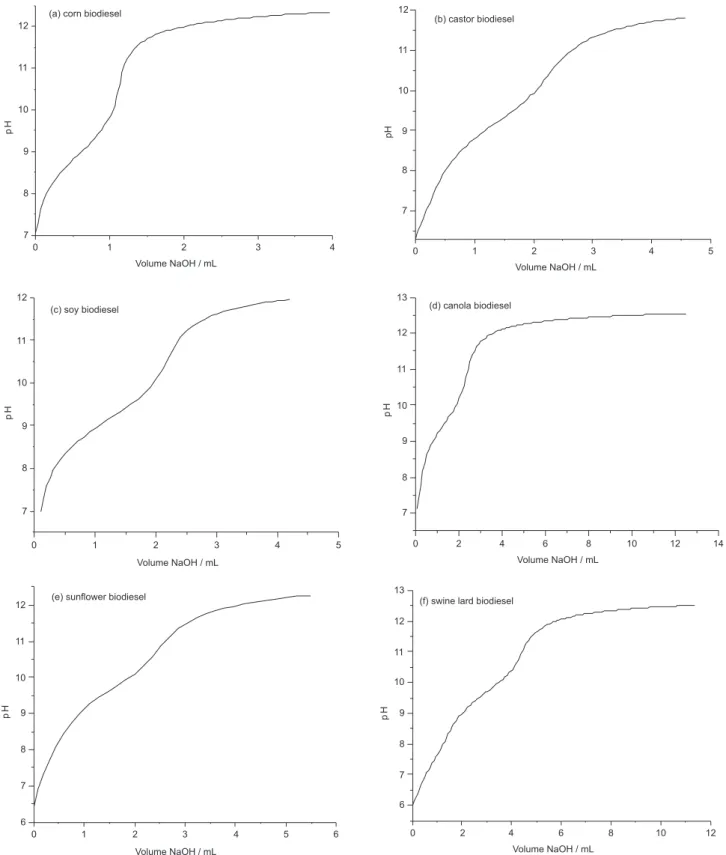Article
J. Braz. Chem. Soc., Vol. 22, No. 6, 1073-1081, 2011. Printed in Brazil - ©2011 Sociedade Brasileira de Química
0103 - 5053 $6.00+0.00
A
*e-mail: tubino@iqm.unicamp.br
A Green Method for Determination of Acid Number of Biodiesel
Matthieu Tubino* and Juliana A. Aricetti
Institute of Chemistry, University of Campinas (UNICAMP), PO 6154, 13083-970 Campinas-SP, Brazil
Neste trabalho é proposto um método simples e verde para a determinação do índice de acidez do biodiesel. A amostra é dissolvida em solução 1:1 v/v etanol:água, evitando a mistura tolueno:isopropanol:água (1:0,95:0,5 v/v/v) usada nas normas atuais. A titulação é realizada com uma solução aquosa de NaOH 0,02 mol L-1. O método foi comparado com o da ABNT NBR 14448, que é similar ao do ASTM D 664 e do EN 14104. A comparação estatística utilizando o teste pareado t de student e o teste F de Snedecor mostrou que o método proposto oferece resultados
equivalentes ao método da norma ABNT NBR 14448, apresentando maior precisão.
A simple green method for the determination of the acid number of biodiesel is described. The sample is dissolved in a 1:1 v/v ethanol:water mixture, avoiding the use of the usual toluene:isopropanol:water mixture (1:0.95:0.5 v/v/v). The titration is performed with a 0.02 mol L-1 NaOH solution in water. The method was compared with that of ABNT NBR 14448, which is similar to ASTM D 664 and to EN 14104. A statistical comparison using the student’s ttestand
the Snedecor F test showed that the proposed method offers equivalent results to ABNT NBR
14448, with better precision.
Keywords: biodiesel, acid number, green method, titration, potentiometry
Introduction
Petroleum is a non-renewable energy source whose price is increasing. Its fuel fractions, mainly gasoline and diesel, may cause severe environmental problems. Therefore several alternative sources of energy have been proposed to replace petroleum-based fuels. Among them, biodiesel appears a promising fuel as it is prepared from renewable sources, such as vegetable and animal fats.1-4 The
physical chemical characteristics of biodiesel are similar to those of common diesel,5-7 so that it can be directly
used in diesel engines, requiring no modiications of these devices.8 Biodiesel also presents some other advantages:
(i) non-toxic and biodegradable, (ii) high lash point and
(iii) less polluting gas emissions.1-3,9-10 Biodiesel is produced
by a relatively simple reaction known as transesteriication, where natural oils and fats made up mainly of triglycerides react with a simple alcohol, such as methanol or ethanol, in the presence of a catalyst, to produce mono alkyl esters of fatty acids.1-2,11
In order to guarantee the quality of the biodiesel several parameters must be determined, among them the acid number which is deined as the quantity, in milligrams of KOH, necessary to neutralize one gram of biodiesel. Since biodiesel presents a high acid number it can generate solid deposits in parts of the engine, mainly in the fuel injector, and it also contributes to corrosion in storage tanks.4 The acid number is
a parameter that informs the quantity of free fatty acids and of acids originating from degradation reactions of biodiesel, for example, the hydrolysis and oxidation of the triglycerides and of the monoesters formed during the production process12
and its storage. Therefore, the acid number is an indication of the oxidation degree of the biodiesel and also of the extent to which it could be degraded.4 As demonstrated by Leung
et al.3 in a study on canola biodiesel stability under various
storage conditions, such as different temperatures, exposure to the atmosphere and the presence of water, the acid number has a tendency to rise with an increase in the temperature.
The ASTM D 664,13 EN 1410414 and ABNT-NBR 1444815
norms were established for the determination of the biodiesel acid number. The ASTM D 66413 and ABNT-NBR 1444815
are used as solvents and potassium hydroxide is used as titrant. The EN 1410414 norm indicates the use of ethanol and diethyl
ether as solvents and potassium hydroxide as titrant. According to these methods, an aliquot of biodiesel is dissolved in the mixture of the solvents and potentiometrically titrated using a glass pH electrode. The standardized solution of KOH is prepared in the respective alcohol. All these solvents present the ability to easily dry the glass membrane of the electrode, leading to slower and less accurate determinations.16 Also, the
toxicity of toluene, diethyl ether and other hazards concerning their manipulation and disposal stimulates the search for an environmentally friendly solvent. In order to maintain the pH electrode in good working condition, it must be periodically allowed to stand in water.17
In the present article, a new and simple method is described where the biodiesel is dissolved in 50% v/v ethanol:water solvent and uses 0.02 mol L-1 NaOH (instead of 0.1 mol L-1
KOH in isopropyl alcohol or ethanol) as the titrating solution. When compared with the literature procedures, the proposed method is: (i) more environmental friendly due to the use of less costly and less hazardous solvents; (ii) simpler to be performed and (iii) more cost effective due to the decrease in consumption of expensive organic solvents and the greater durability of the glass electrode.
Experimental
Instruments
A Metrohm model 691 pH meter and a Metrohm Titrando 808 titrator with Solvotrode Metrohm (LiCl 3.0 mol L-1 in ethanol) and Ecotrode Plus Metrohm
(aqueous KCl 3.0 mol L-1 solution) electrodes were used.
The electrodes were calibrated with buffer solutions of pH 7.00 ± 0.05 and pH 4.00 ± 0.05 (Synth) at 25 ºC before
the analytical determinations.
An ultrasonic bath was used to degasify the solvents and the solutions. A Biohit 50 mL Digital Burette, or a Brand 50 mL Digital Burette III, was used for the point to point titrations.
Reagents and solvents
All the reagents and solvents were of analytical grade. Water was obtained from a continuous distiller.
Biodiesel preparation
The reaction was done using 600 g of the fat, 120 g of methanol (20% m/m of the fat) and 3.36 g of sodium methylate solution (30% m/m methanolic solution was
used), with stirring and heating for 1 h at 60 oC. The
solution obtained was decanted into a separatory funnel to remove the glycerin. The supernatant was transferred to the reaction lask and again reacted with methanol in presence of 0.84 g of the sodium methylate solution. Glycerin was again removed from the inal product, as described above, and the ester obtained was washed with a series of ive 100 mL portions of doubly distilled water to remove residual glycerin, excess of catalyst, methanol and other products, such as NaOH. The washed product was dried with anhydrous sodium sulfate (10% m/m) and iltered.18
The proposed analytical procedure
With precision at least of 0.01 g, 20 g of the sample were weighed directly into a 200 mL tall form beaker. To this, 75.0 mL of a 50:50 v/v water/ethanol mixture was added and gently mixed with a magnetic stirrer for 1 min. The solution was potentiometrically titrated with an aqueous 0.02 mol L-1 sodium hydroxide solution standardized
against potassium biphthalate. After each titration, the electrode was rinsed carefully with a small portion (5 mL) of ethanol to remove traces of biodiesel, followed by washing with distilled water. The electrode was maintained in distilled water for at least one minute to rehydrate the glass membrane.
The ABNT-NBR 1444815 procedure
Weigh the sample directly into a 200 mL tall form beaker. Add 125 mL of the toluene/isopropyl alcohol/ water (1.0:0.95:0.5 v/v/v) mixture and mix gently with a magnetic stirrer for 1 min.
Potentiometrically titrate with 0.1 mol L-1 potassium
hydroxide in isopropyl alcohol standardized against potassium biphthalate. The electrode is rinsed with isopropyl alcohol and the solvent mixture. Then, it is placed in distilled water for 5 min to re-hydrate the glass membrane. It was observed in the present work that after about 10 titrations it is advisable to keep the electrode immersed in a 0.1 mol L-1 HCl solution for at least 24 h in
order to re-activate the glass membrane.
The acid number is calculated using equation 1, where A is the titrant solution volume obtained in milliliters for the sample titration, B is the titrant solution volume in milliliters for the titration of the blank, C is the titrant solution concentration in mol L-1 and m is the mass of the
sample in grams.
Results and Discussion
In order to verify the stability of the basic titrant solutions, 0.1 mol L-1 KOH in isopropyl alcohol (ABNT NBR 1444815
and ASTM D-66413) and 0.02 mol L-1 NaOH in water
(present work), standardization was repeated periodically during 20 days. The solutions of the bases were stored in the closed amber glass bottles of the titrator. Both KOH (RSD = 2.2%) and NaOH (RSD = 1.5%) solutions were stable throughout this period within the precision of the standardization process. These experiments clearly showed that the KOH and NaOH solutions were stable along the time, as indicated by Metrohm, even in the glass bottles that are part of the Titrando 808 automatic titrator. For the manual point to point titrations, the solutions of the bases were stored in polyethylene lasks.
The acid number of the solvents was determined using the reference ABNT NBR 14448 method and by the procedure proposed herein. Figure 1 gives examples of potentiometric titration curves for both solvents. In the case of the ethanol:water solvent, the pH was used for practical purposes as this scale is easier to be visualized by the operator. In this solvent, the use of a pH scale makes sense as it has high water content, in contrast to the ABNT NBR 14448 method in which only organic solvents are used, invalidating direct use of pH.
Table 1 indicates that the values obtained are statistically coincident and that precision is quite better when the aqueous NaOH solution is used as titrant, with the ethanol:water solvent. Therefore, it can be concluded that the aqueous sodium hydroxide solution can replace the potassium hydroxide in isopropyl alcohol solution as titrant with obvious advantages.
Figure 2 represent examples of the potentiometric curves obtained for the titration of methyl biodiesel prepared from corn, castor, soy, canola and sunlower seed oils and from swine lard, using the ABNT NBR 14448 procedure. A Metrohm Titrando 808 titrator was used with a Solvotrode electrode illed with 3.0 mol L-1
LiCl solution in ethanol. Figure 3 represent potentiometric titrations of biodiesels derived from the same oils and fats, using the method proposed in this article and the same experimental set up.
The ABNT NBR 14448 procedure expresses the results in millivolts. In the proposed method the pH scale is used in place of millivolts in order to simplify the visualization of the process by the operator. As the proposed method uses a mixture of 50% of water:ethanol, pH makes some sense, in contrast to the ABNT NBR 14448 method that is performed in an organic solvent mixture. Of course, the pH measurements are not done
Figure 1. Examples of potentiometric titration curves of the used solvents to dissolve biodiesel: (a) toluene:isopropanol:water (1.0: 0.95:0.5 v/v/v), (ABNT NBR 14448) and (b) water:ethanol (50:50 v/v) (proposed method), through Metrohm Solvotrode electrode illed with 3.0 mol L-1
LiCl solution in ethanol in both methods, with a Metrohm Titrando 808 automatic titrator.
Table 1. Quantity of base, in mL of KOH,a necessary to titrate 100 mL
of the solvent used to perform the proposed and the ABNT NBR 1444815
methods
Titrant Proposed method
b ABNT NBR method
water:ethanol toluene:isopropanol:water
KOHc / mg 0.307 ± 0.031 0.655 ± 0.030
NaOHd / mg 0.315 ± 0.005 0.667 ± 0.025
tcalce 0.51 0.61
Fcalcf 38.4 1.4
aEven in the NaOH case, the result is expressed as the corresponding
milligrams of KOH in order to obtain results according the deinition of the acid number; bMetrohm Solvotrode eletctrode illed with 3.0 mol L-1
LiCl solution in ethanol in both methods. Automatic titrator: Metrohm Titrando 808; ctitrant KOH: 0.1 mol L-1; dtitrant NaOH: 0.02 mol L-1; etabled t = 2.31 (n
1 = n2 = 5; α = 0.05); t = 3.36 (n1 = n2 = 5; α = 0.01);19 ftabled F = 6.39 (n
with perfect accuracy as the solvent contains 50% of ethanol. However, high accuracy is not necessary as the aim of the titration is to obtain the equivalence point through the variation of the pH.
Figure 3. Potentiometric titrations of biodiesels from several oils and fats using the method proposed in this article, through Metrohm Solvotrode electrode illed with 3.0 mol L-1 LiCl solution in ethanol, with a Metrohm Titrando 808 automatic titrator.
solution. It can be observed that the proposed method offers better precision than the ABNT NBR 14448 procedure, i.e.
1.5% vs. 3.3%. The statistical paired student’s t comparison
shows agreement between the values obtained with the two
procedures in all cases, i.e. using corn, castor, soy, canola
and sunlower seed oil and swine lard biodiesels.
of the glass membrane was observed, being necessary to immerse the electrode in 0.1 mol L -1 HCl for at least ive
days for its recuperation. In the proposed method, the electrode was washed after each titration, in sequence, with ethanol and distilled water. Then the electrode was immersed in distilled water for about 60 s. Every two weeks the electrode was kept for 24 h in a solution of 0.1 mol L-1
HCl for cleaning and hydration.
Table 3 gives the acid number determined for various biodiesels with the ABNT NBR 14448 method using a Solvotrode electrode illed with 3.0 mol L-1 ethanolic LiCl
solution and using the proposed method with a Metrohm Ecotrode Plus electrode illed with aqueous 3.0 mol L-1 KCl
solution. Figures 4 to 6 show some of the experimental curves. Table 4 summarizes these results. It can be easily noted that those obtained with the proposed method, independent of the electrode used, are better than those furnished by ABNT NBR 14448. Comparing the LiCl and the KCl electrodes used with the proposed method, it can be observed that the latter presents better precision than the former.
According to the data in Table 3, the use of a KCl illed electrode in the proposed method gives results statistically equivalent to those obtained with the ABNT NBR 14448 procedure at the 0.99 conidence level but with a little
better precision, i.e. the mean relative standard deviation
of the developed procedure (1.4%) is smaller than that of the reference method (2.9%).
A point to point titration was also performed for the proposed method using both the LiCl: ethanol- and KCl water-illed electrodes.
Table 5 shows the statistical comparison in terms of accuracy and precision of the results shown in Table 4. It can be noted that there is complete agreement in all cases at a 95% conidence level.
Conclusions
The method proposed in this work for the determination of the acid number of several different biodiesels presents similar performance to the method of regulation ABNT NBR 14448. The experimental comparison between the two methods clearly shows that both procedures provide statistically equivalent results. However, the proposed method presents a signiicant advantage over the ABNT NBR 14448 method as it uses only ethanol and water as solvents, while the other needs the organic solvent toluene. As a consequence of the solvent mixture used in the ABNT NBR 1444815 method (toluene:isopropanol:water; Table 2. Potentiometric determination of the acid number of various biodiesels by the ABNT NBR 1444815 and the proposed methods. A Metrohm
Solvotrode electrode with 3.0 mol L-1 LiCl solution in ethanol and a Metrohm Titrando 808 titrator were used
Biodiesel ABNT NBR RSD / % Proposed RSD / % tcalca Fcalcb
Corn 0.116 ± 0.002 1.7 0.115 ± 0.001 0.9 0.89 4.00
Soy 0.135 ± 0.004 3.0 0.130 ± 0.002 1.5 2.24 4.00
Sunlower 0.177 ± 0.008 4.5 0.176 ± 0.004 2.3 0.22 4.00
Swine lard 0.196 ± 0.006 3.1 0.190 ± 0.002 1.1 1.54 1.44
Castor 0.433 ± 0.019 4.4 0.442 ± 0.006 1.4 0.90 10.0
Canola 0.133 ± 0.004 3.0 0.132 ± 0.002 1.5 0.45 4.00
Mean 3.3 1.5 1.04 4.57
aTabled t = 2.31 (n
1 = n2 = 5; α = 0.05); t = 3.36 (n1 = n2 = 5; α = 0.01);19btabled F = 6.39 (n1 = n2 = 5; α = 0.05); F = 16.0 (n1 = n2 = 5; α = 0.01).19
Table 3. Potentiometric determination of the acid number of various biodiesels by ABNT NBR 1444815 using an Solvotrode electrode illed with 3.0 mol L-1
ethanolic LiCl solution and using the proposed method with Metrohm Ecotrode Plus electrode illed with aqueous 3.0 mol L-1 KCl solution and automatic
titrator Metrohm Titrando 808
Biodiesel ABNT NBR RSD / % KCl RSD / % tcalca Fcalcb
Corn 0.163 ± 0.004 2.5 0.159 ± 0.001 0.6 1.94 16.0
Soy 0.237 ± 0.007 3.0 0.235 ± 0.002 0.9 0.55 12.3
Sunlower 0.177 ± 0.008 4.5 0.176 ± 0.004 2.3 0.22 4.00
Swine lard 0.287 ± 0.010 3.5 0.275 ± 0.006 2.2 2.06 2.78
Castor 0.370 ± 0.005 1.4 0.383 ± 0.003 0.8 2.15 4.84
Canola 0.158 ± 0.004 2.5 0.153 ± 0.002 1.3 2.24 4.00
Mean 2.9 1.4 1.53 7.31
aTabled t = 2.31 (n
Figure 4. Point to point potentiometric titrations of biodiesels from several oils and fats using the ABNT NBR 14448 method, through Metrohm
Solvotrode electrode with 3.0 mol L-1 LiCl solution in ethanol. Figure 5. Point to point potentiometric titrations of biodiesels from several
oils and fats using the proposed method, through Metrohm Solvotrode electrode with 3.0 mol L-1 LiCl solution in ethanol.
1.0:0.95:0.5 v/v/v, with KOH in isopropanol for titrating) the glass electrode membrane is rapidly dehydrated, interfering in its performance. The solvent used in the proposed method (ethanol:water; 50:50 v/v, with NaOH in water for titrating) does not have a signiicant effect on the membrane. Experimental procedure of the proposed method
Table 4. Acid number of corn, soy and castor biodiesel from point to point titrations using the ABNT NBR 1444815 method and the proposed method using
the Solvotrode electrode illed with 3.0 mol L-1 ethanolic LiCl solution or the Metrohm Ecotrode Plus electrode illed with aqueous 3.0 mol L-1 KCl solution
ABNT NBR 14448 Proposed method
Biodiesel Solvotrode electrode RSD / % Solvotrode electrode RSD / % Ecotrode electrode RSD / %
Corn 0.170 ± 0.008 4.7 0.163 ± 0.004 2.5 0.167 ± 0.005 3.0
Soy 0.230 ± 0.008 3.5 0.214 ± 0.006 2.8 0.214 ± 0.002 0.9
Castor 0.446 ± 0.019 4.3 0.431 ± 0.011 2.6 0.423 ± 0.005 1.2
Mean 4.2 2.6 1.7
Figure 6. Point to point potentiometric titrations of biodiesels from several oils and fats using the proposed method, through Metrohm Ecotrode Plus electrode illed with aqueous 3.0 mol L-1 KCl solution.
Table 5. Statistical tests of the acid value of biodiesels made with point to point titrations
ABNT vs. LiCla ABNT vs. KClb LiClavs. KClb
Biodiesel tcalcc Fcalcd tcalcc Fcalcd tcalcc Fcalcd
Corn 1.11 4.00 0.45 1.56 0.88 1.56
Soy 2.26 1.78 2.74 16.00 0.22 9.00
Castor 0.97 2.98 1.66 14.4 0.94 4.84 Mean 1.56 2.92 1.62 10.65 0.68 5.13
aSolvotrode electrode iled with 3.0 mol L-1 LiCl in ethanol; bEcotrode
electrode filed with 3.0 mol L-1 KCl in water; ctabled t = 2.78
(n1 = n2 = n3 = 3; α = 0.05); t = 4.60 (n1 = n2 = n3 = 3; α = 0.01);19dtabled
F = 19.0 (n1 = n2 = n3 = 3; α = 0.05); F = 99.0 (n1 = n2 = n3 = 3; α = 0.01).19 Based on our results and these considerations, the proposed procedure can be recommended for the determination of the acid number in biodiesel as it gives reliable, accurate and precise results. The present method is very simple to perform, of low cost and also presents a low level of toxicity and of possible environmental contamination.
Acknowledgments
The authors are grateful to Conselho Nacional de Desenvolvimento Científico e Tecnológico (CNPq), Fundação de Amparo à Pesquisa do Estado de São Paulo (FAPESP) and Coordenação de Aperfeiçoamento de Pessoal de Nível Superior (CAPES) for inancial support and to Prof. Carol H. Collins for English revision of the manuscript.
References
1. Ramos, M. J.; Fernandéz, C. M.; Casas, A.; Rodrigues, L.; Pérez. Á.; Bioresour. Technol. 2009, 100, 261.
2. Bouaid, A.; Martinez, M.; Aracil, J.; Bioresour. Technol. 2009, 100, 2234.
3. Leung, D. Y. C.; Koo, B. C. P.; Guo, Y.; Bioresour. Technol. 2006, 97, 250.
5. Rinaldi, R.; Garcia, C.; Marciniuk, L.L; Rossi, A. V.; Schuchardt, U.; Quim. Nova 2007, 30, 1374.
6. Schuchardt, U.; Sercheli, R.; Vargas, R. M.; J. Braz. Chem. Soc. 1998, 9, 199.
7. Monteiro, M. R.; Ambrozin, A. R. P.; Lião, L. M.; Ferreira, A. G.; Talanta 2008, 77, 593.
8. S. Stournas, E. L.; Serdari, A.; J. Am. Oil Chem. Soc. 1995, 72, 240.
9. Knothe, G.; Steidley, K. R.; Fuel 2007, 86, 2560. 10. Ferrari, R. A.; Souza, W. L.; Quim. Nova 2007, 32, 106. 11. Bajpai, D.; Tyagi, V. K.; J. Oleo Sci. 2006, 55, 487.
12. Mahajan, S.; Konar, S. K.; Boocock, D. G. B.; J. Am. Oil Chem. Soc. 2006, 83, 567.
13. ASTM D664: Standard Test Method for Acid Number of Petroleum Products by Potentiometric Titration, Philadelphia, 2009.
14. EN 14104: Fat and Oil Derivatives - Fatty Acid Methyl Esters (FAME), Determination of Acid Value, European Committee for Standardization, Berlin, 2003.
15. ABNT NBR 14448: Produtos de Petróleo – Determinação do Número de Acidez pelo Método de Titulação Potenciométrica, Rio de Janeiro, Brasil, 2009. www.abnt.org.br
16. Greenhow, E. J.; Al-Mudarris, B. F.; Talanta 1975, 22, 417. 17. Karlberg, B.; Anal. Chim. Acta 1973, 66, 93.
18. Aricetti, J. A.; Maciel, A. J. S.; Lopes, O. C.; Tubino. M.; J. ASTM Int. 2010, 7, Paper ID JAI102516. www.astm.org 19. Eckschlager, K.; Errors, Measurement and Results in Chemical
Analysis, Van Nostrand Reinhold Company: London, 1972, pp. 109-113.
Submitted: September 24, 2010
Published online: February 15, 2011





